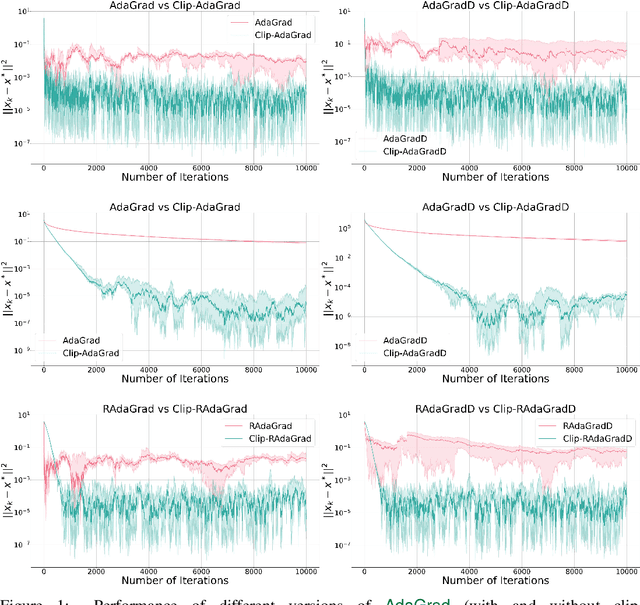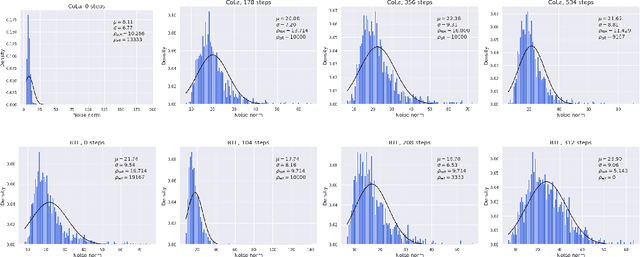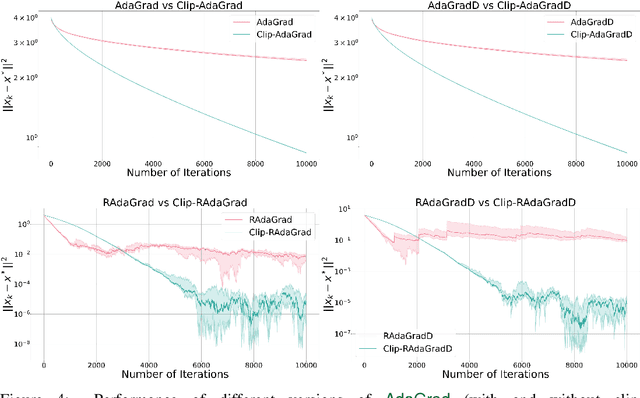Andrei Semenov
Sign Operator for Coping with Heavy-Tailed Noise: High Probability Convergence Bounds with Extensions to Distributed Optimization and Comparison Oracle
Feb 11, 2025Abstract:The growing popularity of AI optimization problems involving severely corrupted data has increased the demand for methods capable of handling heavy-tailed noise, i.e., noise with bounded $\kappa$-th moment, $\kappa \in (1,2]$. For the widely used clipping technique, effectiveness heavily depends on the careful tuning of clipping levels throughout training. In this paper, we demonstrate that using only the sign of the input, without introducing additional hyperparameters, is sufficient to cope with heavy-tailed noise effectively. For smooth non-convex functions, we prove that SignSGD achieves optimal sample complexity $\tilde{O}\left(\varepsilon^{-\frac{3\kappa - 2}{\kappa - 1}}\right)$ with high probability for attaining an average gradient norm accuracy of $\varepsilon$. Under the assumption of symmetric noise, we use SignSGD with Majority Voting to extend this bound to the distributed optimization or reduce the sample complexity to $\tilde{O}(\varepsilon^{-4})$ in the case of a single worker with arbitrary parameters. Furthermore, we explore the application of the sign operator in zeroth-order optimization with an oracle that can only compare function values at two different points. We propose a novel method, MajorityVote-CompsSGD, and provide the first-known high-probability bound $\tilde{O}(\varepsilon^{-6})$ for the number of comparisons under symmetric noise assumption. Our theoretical findings are supported by the superior performance of sign-based methods in training Large Language Models.
Just a Simple Transformation is Enough for Data Protection in Vertical Federated Learning
Dec 16, 2024Abstract:Vertical Federated Learning (VFL) aims to enable collaborative training of deep learning models while maintaining privacy protection. However, the VFL procedure still has components that are vulnerable to attacks by malicious parties. In our work, we consider feature reconstruction attacks, a common risk targeting input data compromise. We theoretically claim that feature reconstruction attacks cannot succeed without knowledge of the prior distribution on data. Consequently, we demonstrate that even simple model architecture transformations can significantly impact the protection of input data during VFL. Confirming these findings with experimental results, we show that MLP-based models are resistant to state-of-the-art feature reconstruction attacks.
Mixed Newton Method for Optimization in Complex Spaces
Jul 29, 2024Abstract:In this paper, we modify and apply the recently introduced Mixed Newton Method, which is originally designed for minimizing real-valued functions of complex variables, to the minimization of real-valued functions of real variables by extending the functions to complex space. We show that arbitrary regularizations preserve the favorable local convergence properties of the method, and construct a special type of regularization used to prevent convergence to complex minima. We compare several variants of the method applied to training neural networks with real and complex parameters.
Gradient Clipping Improves AdaGrad when the Noise Is Heavy-Tailed
Jun 06, 2024



Abstract:Methods with adaptive stepsizes, such as AdaGrad and Adam, are essential for training modern Deep Learning models, especially Large Language Models. Typically, the noise in the stochastic gradients is heavy-tailed for the later ones. Gradient clipping provably helps to achieve good high-probability convergence for such noises. However, despite the similarity between AdaGrad/Adam and Clip-SGD, the high-probability convergence of AdaGrad/Adam has not been studied in this case. In this work, we prove that AdaGrad (and its delayed version) can have provably bad high-probability convergence if the noise is heavy-tailed. To fix this issue, we propose a new version of AdaGrad called Clip-RAdaGradD (Clipped Reweighted AdaGrad with Delay) and prove its high-probability convergence bounds with polylogarithmic dependence on the confidence level for smooth convex/non-convex stochastic optimization with heavy-tailed noise. Our empirical evaluations, including NLP model fine-tuning, highlight the superiority of clipped versions of AdaGrad/Adam in handling the heavy-tailed noise.
Sparse Concept Bottleneck Models: Gumbel Tricks in Contrastive Learning
Apr 04, 2024



Abstract:We propose a novel architecture and method of explainable classification with Concept Bottleneck Models (CBMs). While SOTA approaches to Image Classification task work as a black box, there is a growing demand for models that would provide interpreted results. Such a models often learn to predict the distribution over class labels using additional description of this target instances, called concepts. However, existing Bottleneck methods have a number of limitations: their accuracy is lower than that of a standard model and CBMs require an additional set of concepts to leverage. We provide a framework for creating Concept Bottleneck Model from pre-trained multi-modal encoder and new CLIP-like architectures. By introducing a new type of layers known as Concept Bottleneck Layers, we outline three methods for training them: with $\ell_1$-loss, contrastive loss and loss function based on Gumbel-Softmax distribution (Sparse-CBM), while final FC layer is still trained with Cross-Entropy. We show a significant increase in accuracy using sparse hidden layers in CLIP-based bottleneck models. Which means that sparse representation of concepts activation vector is meaningful in Concept Bottleneck Models. Moreover, with our Concept Matrix Search algorithm we can improve CLIP predictions on complex datasets without any additional training or fine-tuning. The code is available at: https://github.com/Andron00e/SparseCBM.
 Add to Chrome
Add to Chrome Add to Firefox
Add to Firefox Add to Edge
Add to Edge